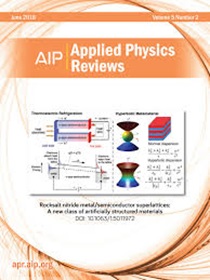Recent progress in brain-like chips based on optoelectronic memory: Structures, mechanisms, and prospects
IF 11.6
1区 物理与天体物理
Q1 PHYSICS, APPLIED
引用次数: 0
Abstract
Optoelectronic brain-like devices have been widely investigated in recent years and are considered a new generation of hardware platforms for neuromorphic computing. Inspired by the biological visual perception system, the devices integrate sensing, computing, and memory in a single functional unit. Compared with the electronically controlled memristor, the introduction of optical signals can further improve the computational efficiency and physically integrate the sensing unit and the processing unit. This efficient and intelligent information processing method can effectively overcome the bottleneck of traditional computing under von Neumann architecture. However, the development of optoelectronic brain-like devices is still in the preliminary stage, and its mechanism is complex and not uniform. Therefore, it is necessary to deeply understand the quantum process between optical input and electrical output to provide a better reference for the development of this field. This article aims to comprehensively review the latest progress in optoelectronic brain-like devices, summarizing the device performance and structures. It also provides a comprehensive summary of multiple mechanisms under different material systems, such as direct photoelectric conversion or photoelectric conversion triggering subsequent effects. In addition, a variety of potential application scenarios for optoelectronic devices are introduced. Finally, we present some possible problems in the development of this field. This review can help researchers better understand the whole picture of the development of optoelectronic devices.基于光电存储器的类脑芯片的最新进展:结构、机制与展望
近年来,光电类脑器件得到了广泛的研究,被认为是神经形态计算的新一代硬件平台。受生物视觉感知系统的启发,该设备将传感、计算和记忆集成在一个功能单元中。与电控忆阻器相比,光信号的引入可以进一步提高计算效率,并将传感单元和处理单元物理集成。这种高效、智能的信息处理方法可以有效地克服冯·诺依曼架构下传统计算的瓶颈。然而,光电类脑器件的发展仍处于初级阶段,其机制复杂且不统一。因此,有必要深入了解光输入与电输出之间的量子过程,为该领域的发展提供更好的参考。本文综述了光电类脑器件的最新研究进展,综述了器件的性能和结构。全面总结了不同材料体系下光电直接转换或光电转换触发后续效应等多种机理。此外,还介绍了光电子器件的各种潜在应用场景。最后,提出了该领域发展中可能存在的问题。这一综述可以帮助研究人员更好地了解光电子器件发展的全貌。
本文章由计算机程序翻译,如有差异,请以英文原文为准。
求助全文
约1分钟内获得全文
求助全文
来源期刊

Applied physics reviews
PHYSICS, APPLIED-
CiteScore
22.50
自引率
2.00%
发文量
113
审稿时长
2 months
期刊介绍:
Applied Physics Reviews (APR) is a journal featuring articles on critical topics in experimental or theoretical research in applied physics and applications of physics to other scientific and engineering branches. The publication includes two main types of articles:
Original Research: These articles report on high-quality, novel research studies that are of significant interest to the applied physics community.
Reviews: Review articles in APR can either be authoritative and comprehensive assessments of established areas of applied physics or short, timely reviews of recent advances in established fields or emerging areas of applied physics.
 求助内容:
求助内容: 应助结果提醒方式:
应助结果提醒方式:


